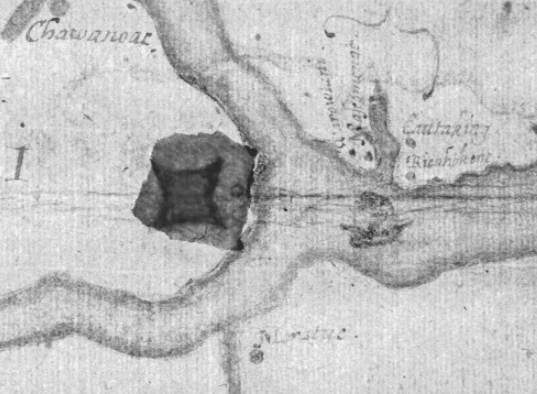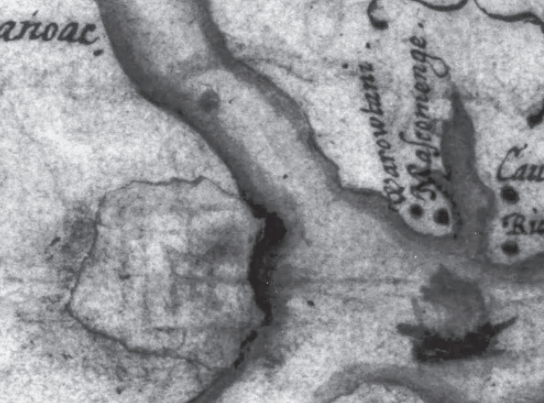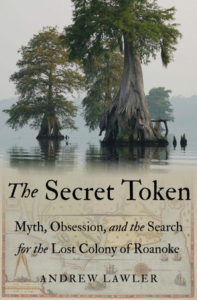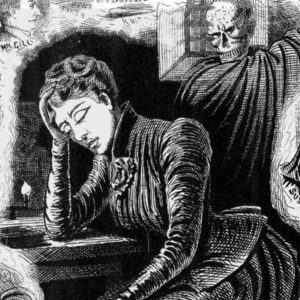The print room at the British Museum is well hidden from the thousands who mill through the endless maze of exhibit rooms. I wandered through the labyrinth, thoroughly lost, until a guard directed me to a nearly invisible entrance in a small gallery on the top floor. Stepping through the doorway was like entering the wardrobe in the C.S. Lewis novel.
Inside was a room as big as a train station, lit by Victorian skylights and supported by Ionic columns. Mahogany shelves filled with tall red-bound books and boxes lined the walls nearly to the ceiling. At one end stood a platform with a desk surrounded by a wooden rail. From here, the librarian in charge surveyed the room in a glance like a judge in a courtroom.
After I signed in, a curator appeared, introducing herself as Alice Rugheimer. She had been on the team that analyzed the map and said Kim Sloan was in a meeting but would be along soon. “Would you like to see the drawings in the meantime?” A few minutes later she rolled a metal cart to a long polished table and unloaded four red boxes. The curator then handed me a pair of white cotton gloves and left me alone with the entire collection of seventy-five John White watercolors.
Their survival is itself a dramatic tale of loss and recovery, a rare example of something related to the Lost Colony that was never fully lost. The delicate watercolors vanished into a private library in Ireland some time after White’s death. In 1865 they were brought to London to be auctioned at Sotheby’s. Just before the sale, a catastrophic fire swept through the warehouse where they were stored. All seventeen thousand volumes of German naturalist Alexander von Humboldt’s library and nearly every first edition of the early American classic The Pilgrim’s Progress went up in smoke before fire fighters could pump thousands of gallons of water to extinguish the blaze.
A few days later, a Vermonter named Henry Stevens poked through the wet and smoking ruins. Stevens specialized in buying books about early America for wealthy patrons. He had been eager to purchase the White drawings that were the basis of so many famous engravings about the New World. According to Lane, Stevens stumbled on the singed and waterlogged White volume and took it to his bookbinder, who cleaned and rebound the material and returned it to Sotheby’s, where he subsequently purchased the set. When he failed to drum up interest among American buyers for the drawings—there were few buyers in the immediate aftermath of the Civil War—he sold the lot to the British Museum. “How miraculous this stuff ever survived!” Lane had remarked.
I opened the first box and pulled out the top image. Each painting is only ten inches by five inches. They are among the few objects that we know were handled—and, in fact, created—by a member of the Roanoke voyages. I looked into the kindly face of a grizzled old man huddled in his winter garment of soft deerskin and worn moccasins. The artist clearly persuaded his subject to haul out his cold-weather clothes, because he met him in the muggy Carolina heat of the 1585 summer.
“One of their religious men” looked as dour as a Puritan preacher except for the earrings and topknot. I imagined him debating theology with Harriot over a cup of sassafras tea. There was “the yer,” a muscled and clean-shaven holy man with feathers in his hair and his arms aloft as if in an ecstatic trance. I came to the painting of Secotan, with its neat rectangular houses and their arched roofs made of reed mats, lacking any defensive wall. The villagers were busy in a host of daily activities, from scaring birds away from the maturing corn to “dancing about poles carved on the tops like faces of men.”
Sloan arrived then in gray tweed and a black turtleneck, a slim woman with her silver hair pulled back. Like Brent Lane, her last name is tied to the Roanoke voyages; Sir Hans Sloane founded the British Museum and also purchased a separate set of drawings associated with John White that are dominated by New World flora and fauna. “I’m not directly related, but all Sloans are related eventually from a Scottish clan, and my father is from Northern Ireland,” she said.
The curator explained that White drew on fine French paper, later mounted on thin boards, which made it impossible to examine the reverse side. After many decades of handling, splotches left by greasy fingers dappled the edges; small tears had become evident. So in preparation for an upcoming 2007 exhibition, Sloan decided to replace them.
For the first time in more than a century, the backsides of the drawings were easily accessible.Her staff laboriously removed the mounts that had stuck to the edges of the fragile drawings. Using a light box of the sort once common for sorting slides, they pinpointed weak areas and fixed tears using a gluten-free wheat-starch paste that can easily be removed. Lightweight Japanese paper replaced the board backings, and the drawings were then fitted into cream-colored acid-free mounts. For the first time in more than a century, the backsides of the drawings were easily accessible.
 By placing the White map on a light table, Sloan and Rugheimer revealed this image of a fort hidden underneath the upper patch covering the head of the Albemarle Sound.
By placing the White map on a light table, Sloan and Rugheimer revealed this image of a fort hidden underneath the upper patch covering the head of the Albemarle Sound.Circles indicate Native American settlements. Courtesy of Trustees of the British Museum
At the time, the curators didn’t take any special note of the patches on the White map. Patches, after all, are not unheard of in paintings of the day. “I have some examples from Pre-Raphaelites where they have done a detailed drawing and want to fix one bit,” Sloan said. “They will draw it on another piece of paper, cut it out, and stick it on.” It was the delete key of that era. Unlike oils, watercolors are difficult to paint over. “My automatic assumption was that White got something wrong and he corrected it.”
I asked how she went about examining the White map after Lane made his request. “It was a Friday,” she said. “It’s always on a Friday. We were both so busy, but Alice said, ‘Let’s do this!’ We thought with a strong light behind it we might be able to see if the inlets and villages were in a different place underneath.” She took the map to a museum conservation lab and laid it in the light box they had used to repair the drawings in order to examine the patch laid over the area of Secotan.
 Ultraviolet analysis of the White map reveals not just a fort symbol hidden beneath but a separate outline of a fortification, likely outlined in urine-based invisible ink, on top of the patch. Courtesy of Trustees of the British Museum
Ultraviolet analysis of the White map reveals not just a fort symbol hidden beneath but a separate outline of a fortification, likely outlined in urine-based invisible ink, on top of the patch. Courtesy of Trustees of the British Museum
As she spoke, Sloan removed the White map from its box and placed it on the table in front of us. Its colors were pale but beautiful, the shorelines outlined in a slightly deeper blue than the off shore waters. Rugheimer had brought a portable light box and plugged it in at the long table where we sat under the gray London afternoon filtering through the skylights above. The outlines of the patches were clearly visible.
Sloan slid the box under the bottom part of the map, around Secotan. “You see the little lines there? That looked like pencil. White changed it, as if there was a river going in the wrong place and he made a correction. It all seemed to make sense.” The patch over the area around Secotan alters the shoreline and placement of one village. Perhaps Thomas Harriot, White’s colleague and the mathematical mind behind the map, insisted that the artist make the correction after revising his own calculations.
Later analysis found that both patches adhered so strongly to the drawing that they could not be removed without risking a tear. By using a camera with filters for infrared and ultraviolet imaging, the team was able to enhance the watercolor. The infrared light picked up White’s initial pencil sketches underlying the entire image. Most of the changes he made from drawing to painting were minor. There was the ghost outline of a ship riding o the coast that was never actually painted, and the rigging altered in one that was.
White had easily painted over his pencil drawings, but it was more difficult to cover the blue outlines of the shore and the village placement along the squiggly coast of the Secotan area. He apparently covered the entire region with a patch. Then he could make small changes to the shore and move the location of the settlement called Secotaoc, located downstream from Secotan on the Pamlico River. The blue pigment used for both the original and the correction appears to be the same, suggesting that it was White or an assistant who made the alteration.
“We thought that was what Brent wanted to know,” Sloan added. “But we said while we are at it, we would look at the other patch. It’s not that easy to see unless you have it under the right kind of light.” The team had a camera to photograph their finds, and Sloan was looking through the view finder that day when an assistant moved the map up to the patch on the northern end.
“I said to Alice, ‘I think we just discovered the intended site of the Cittie of Raleigh.’ Then I swore.” Her tone was of dread rather than delight.
“I’ve looked at enough old maps, and I knew the symbol. I had that ‘Oh. My. God.’ moment.”“I’ve looked at enough old maps, and I knew the symbol. I had that ‘Oh. My. God.’ moment. As in ‘Oh my God’ there are going to be so many people asking about this damn thing. I knew the first question would be about the Lost Colony. I didn’t want to be the person who discovered the patch and therefore would be the go-to person for the answers to everything. And we don’t know the answer. Because without more documentation, there is no answer to why he covered it up.”
She slid the upper part of the map over the light, just where the Albemarle Sound split into the Roanoke and Chowan Rivers. What seemed a blank space suddenly revealed a bright star-shaped lozenge in deep red and outlined in a royal blue.
Image processing enhanced the symbol. A dark feature, possibly the outlines of a square, sits in the center of the lozenge. There was no mistaking the form. White had drawn, and then hidden, a common representation of a Renaissance-era fort, located about fifty miles inland from Roanoke Island. It recalls his mention that the settlers intended to move “fifty miles into the main.” The blue pigment proved similar to the paint White used for the coastlines, again suggesting the change was made by the artist himself. After more than four centuries, a secret that John White so carefully concealed was revealed.
__________________________________
From the book: THE SECRET TOKEN by Andrew Lawler, Copyright © 2018 by Andrew Lawler. Published by arrangement with Doubleday, an imprint of The Knopf Doubleday Publishing Group, a division of Penguin Random House Inc.


















